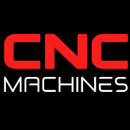Parts of a CNC Machine — CNC Block Diagram

7 Parts of a CNC Machine +7 CNC Block Diagram
CNC (Computer Numerical Control) machines have revolutionized modern manufacturing by automating precision tasks, reducing human error, and increasing production efficiency. Understanding the key components of a CNC machine is crucial for anyone involved in manufacturing or interested in this technology. In this article, we will explore the main parts of a CNC machine and explain the CNC block diagram in simple terms.
7 Key Components of a CNC Machine
1. Machine Control Unit (MCU)
The Machine Control Unit is the brain of the CNC machine. It reads the G-code (the programming language for CNC) and converts it into electrical signals that control the machine's movements. The MCU processes data, coordinates the movement of axes, and monitors the operation to ensure accuracy and precision.
2. Input Devices
Input devices include the computer or microcontroller where the CNC program is loaded. Operators use these devices to input commands and data into the MCU. Common input devices are keyboards, USB ports, and network connections.
3. Drive System
The drive system is responsible for moving the machine components. It includes motors (usually stepper or servo motors), amplifiers, and the mechanism for converting rotational motion into linear motion, such as lead screws or ball screws. The drive system ensures that the tool moves accurately according to the programmed instructions.
4. Machine Tool
The machine tool is the part of the CNC machine that actually performs the cutting, drilling, or milling operations. It can be a spindle holding various types of cutting tools or other attachments depending on the machine's purpose. The tool's movement is precisely controlled to shape or cut the material.
5. Feedback System
The feedback system ensures that the machine operates correctly by constantly monitoring its position and movement. It uses sensors like encoders and linear scales to provide real-time data to the MCU, allowing it to make necessary adjustments for maintaining accuracy.
6. Bed and Table
The bed and table form the foundation and workspace of the CNC machine. The bed is a sturdy base that supports the entire machine, while the table is the surface where the material (workpiece) is placed. The table can move along different axes, usually X, Y, and Z, to position the workpiece correctly under the machine tool.
7. Cooling System
The cooling system is essential for maintaining the machine's performance and longevity. It prevents overheating of both the machine tool and the workpiece by using coolants, which are often liquids sprayed onto the cutting area to dissipate heat and lubricate the cutting process.
(7) CNC Block Diagram Explained
A CNC block diagram is a visual representation of the CNC machine’s components and their interactions. Here is a simplified explanation of the main blocks in a typical CNC diagram:
1. Input Block
This block represents the input devices where the CNC program is entered. It includes computers, keyboards, and other devices used to feed data into the MCU.
2. MCU Block
The MCU block processes the input data, converts it into electrical signals, and sends instructions to the drive system. It is connected to the input block and other components like the feedback system and drive system.
3. Drive System Block
This block includes the motors and mechanisms that move the machine parts. It receives signals from the MCU and executes the movements as per the program.
4. Machine Tool Block
Representing the cutting tool or spindle, this block is directly controlled by the drive system and performs the actual machining operations on the workpiece.
5. Feedback System Block
This block monitors the position and movement of the machine parts. It sends real-time data back to the MCU to ensure precise control and adjustment.
6. Bed and Table Block
Representing the foundation and workspace, this block shows where the material is placed and how it moves under the tool.
7. Cooling System Block
This block indicates the system that manages heat and lubrication during the machining process to prevent damage and maintain efficiency.
Understanding the parts of a CNC machine and their functions, as illustrated in the CNC block diagram, is fundamental for anyone working with or learning about CNC technology. Each component plays a critical role in ensuring the machine operates accurately and efficiently, resulting in high-quality products and streamlined manufacturing processes. By mastering these basics, you'll be well on your way to leveraging the full potential of CNC machines in your projects.



